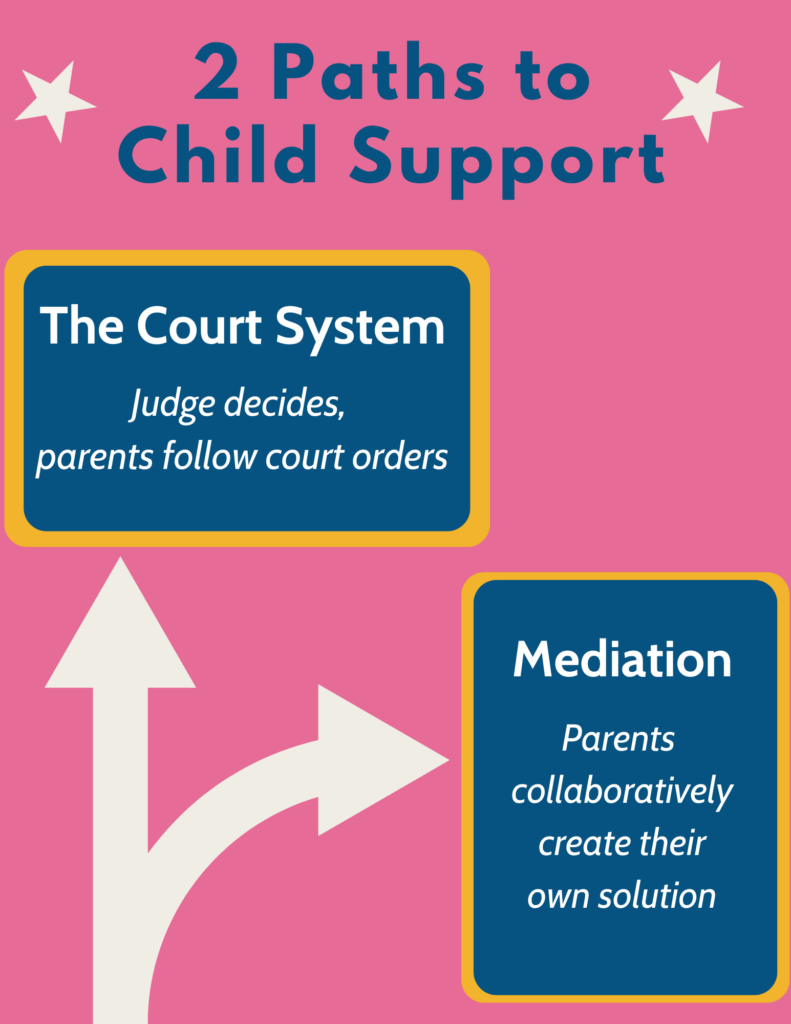We know that when you’re going through a divorce, you have so much on your plate: managing logistics, looking after your own well-being, coping with stress, building your career, dealing with mental health challenges, and feeling a mix of fear, excitement, grief, and hope for what’s next. If you’re a parent, you also have the huge responsibility of ensuring your child’s physical, emotional, and mental well-being.
Child support is a regular payment made by a parent to help cover a child’s expenses after a divorce or separation.
Ideally, a child support order ensures that both parents contribute financially to support their child’s needs and upbringing.

The 2 paths to child support
If you and your partner are separating and have children, you’ll need a plan to keep them financially and emotionally secure. The good news is, you don’t always have to go through the court system—child support agreements can often be settled through mediation.
Only you know what will work best for your family. We’re here to arm with you with the information you need to make informed decisions.
I’m pursuing child support through the court system. How does it work?
Rules & processes vary by state, but generally you take these steps:
Fill Out Paperwork: Each state’s family court has its own forms. Be ready to provide proof of parentage and both parents’ income details, including changes over time.
Attend A Hearing: Once paperwork is completed, you’ll meet with a family court judge. Both parents can present additional information that might impact child support responsibilities.
Follow The Court’s Decision: After the hearing, the judge will issue a child support order that details payment amounts, who pays whom, and how often payments should be made. Both parents are legally required to follow this order, with penalties for non-compliance.
How is child support calculated?
Child support formulas can seem both simple and complex at the same time. The tricky part is that every family’s situation is unique, so the final amount can be influenced by many individual factors. Also, judges have the power to adjust the formula based on special circumstances → meaning they can decide to increase or decrease the support amount depending on your case.
Each state has its own rules for calculating child support. Make sure you (or your team) understand how your state handles these calculations to know how the final amount is determined.
Two common models used by states to calculate child support are:
- The Income Shares Model – This model considers the combined income of both parents to estimate the amount of support needed to maintain the child’s standard of living. The goal is to ensure the child gets the same amount of financial support they would have received if the parents were living together.
- The Percentage of Income Model – This model bases the amount of child support on a percentage of the non-custodial parent’s income. The percentage varies depending on how many children are involved.
Each state may have its own version of these models, with slightly different rules and numbers to consider, so be sure you or your team know how your state applies these methods to determine the right amount of child support.
I’m pursuing child support through mediation. How does it work?
Through mediation parents can create an arrangement tailored to their family’s needs rather than following a standard court order. Many parents find this option appealing, as it can better reflect their unique lifestyle and situation.
The best things you can do are – Be prepared with all the necessary documents and bring a collaborative mindset that is open to negotiation. Here’s what a mediator will focus on:
- Finances: The mediator will review both parents’ financial information to determine fair support for the children.
- Physical & emotional needs of kids: The mediator will consider how best to support the children’s well-being.
- Financial Contributions: If there’s anything unique about your family’s finances, like out-of-home childcare or help from relatives with schooling, let the mediator know. The goal is to create a balanced, fair agreement.
How to prepare for child support mediation
Outline Your Parenting Goals → Think about what you’d like custody and visitation to look like. Would you both prefer 50/50 custody, or would a different arrangement work better? Write down your ideas to bring to mediation.
Commit To Cooperative Decision Making → Being able to work together on decisions for your kids, from school to family time, will be important. Show that you’re willing to collaborate.
Stay Calm and Focused → Emotions can run high, but having a plan in place can help. Avoid negative talk about the other parent. Sticking to your plan will help keep the discussion constructive and positive.
Mediation for child support doesn’t work for everyone
Mediation can be a great option for parents who want to keep things friendly, especially for the sake of the kids. But it’s not for everyone, as in the following situations:
- One or both parents refuse to communicate – Communication is essential when figuring out how to support your children. If there’s too much tension, it might be best to go through the court system with separate lawyers.
- One parent won’t accept the split – If one person is not ready to accept the end of the relationship, mediation likely won’t work. Court proceedings may be a better choice once it’s clear both parties are ready to move forward.
- There’s sensitive information that can’t stay confidential – In cases involving potential abuse or other serious concerns, the law may require a mediator to disclose certain information. For situations like this, handling the separation through court is often best.
